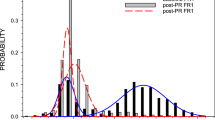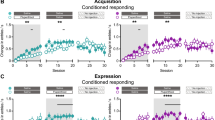Abstract
The effect of pimozide on conditioned reinforcement was determined by comparing rate of lever pressing for a tone in groups previously treated with or without the drug when the tone was paired with food. Eight groups of six to eight rats each received three phases of training in a two-lever box. The pre-exposure phase measured the operant rate of pressing the two levers, one of which produced a 3 s tone. In the conditioning phase, with the levers absent, the tone was paired with food over four sessions. The test phase again measured the rate of pressing the two levers. In an undrugged experimental group (i.e., Paradigm group), the number of presses on the tone lever significantly increased from the pre-exposure to the test phase, thereby confirming that the procedure could establish conditioned reinforcement. A control group receiving tones and pellets randomly during the conditioning phase also showed conditioned reinforcement but a group receiving negatively correlated tones and pellets did not. Groups receiving the dopamine-receptor blocker pimozide (1.0 mg/kg) prior to each conditioning session failed to show conditioned reinforcement in the test session. Control groups ruled out state dependent learning and drug-induced performance impairments as explanations of this pimozide-related effect. These data may indicate a possible role for dopamine neurons in mediating the control of behavior by certain positive reinforcing stimuli.
Similar content being viewed by others
References
Beninger, R. J., Mason, S. T., Phillips, A. G., Fibiger, H. C.: The use of conditioned suppression to evaluate the nature of neurolepticinduced avoidance deficits. J. Pharmacol. Exp. Ther. (in press, 1980)
Bersh, P. J.: The influence of two variables upon the establishment of a secondary reinforcer for operant responses. J. Exp. Psychol. 41, 62–73 (1951)
Crow, T. J.: Catecholamine-containing neurons and electrical selfstimulation. 1. A theoretical interpretation and some psychiatric implications Psychol. Med. 3, 66–73 (1973)
Fibiger, H. C.: Drugs and reinforcement mechanisms: A critical review of the catecholamine theory. Ann. Rev. Pharmacol. Toxicol. 18, 37–51 (1978)
Fibiger, H. C., Zis, A. P., Phillips, A. G.: Haloperidol-induced disruption of conditioned avoidance responding: Attenuation by prior training or by anticholinergic drugs. Eur. J. Pharmacol. 30, 309–314 (1975)
German, D. C., Bowden, D. M.: Catecholamine systems as the neural substrate for intracranial self-stimulation: A hypothesis. Brain Res. 73, 381–419 (1974)
Hill, R. T.: Facilitation of conditioned reinforcement as a mechanism of psychomotor stimulation. In: Amphetamines and related compounds, E. Costa, S. Garattini, eds., pp. 781–795. New York: Raven Press 1970
Jenkins, W. O.: A temporal gradient of derived reinforcement. Amer. J. Psychol. 63, 237–243 (1950)
Knott, P. D., Clayton, K. N.: Durable secondary reinforcement using brain stimulation as the primary reinforcer. J. Comp. Physiol. Psychol. 61, 151–153 (1966)
Kremer, E. F.: Truly random and traditional control procedures in CER conditioning in the rat. J. Comp. Physiol. Psychol. 76, 441–448 (1971)
Kremer, E. F., Kamin, L. J.: The truly random control procedure: Associative and nonassociative effects in rats. J. Comp. Physiol. Psychol. 74, 203–210 (1971)
Mackintosh, N. J.: The psychology of animal learning. New York: Academic Press 1974
Mason, S. T., Beninger, R. J., Fibinger, H. C., Phillips, A. G.: Pimozideinduced suppression of responding: Evidence against a block of food reward. Pharmacol. Biochem. Behav. (in press, 1980)
Mogenson, G. J., Phillips, A. G.: Brain-stimulation reward after twenty-five years. Canad. J. Psychol. 32, 54–57 (1978)
Olds, J., Milner, P.: Positive reinforcement produced by electrical stimulation of septal area and other regions of the brain. J. Comp. Physiol. Psychol. 47, 419–427 (1954)
Overton, D. A.: Experimental methods for the study of statedependent learning. Fed. Proc. 33, 1800–1813 (1974)
Phillips, A. G., Fibiger, H. C.: The role of dopamine in maintaining intracranial self-stimulation in the ventral tegmentum, nucleus accumbens, and medial prefrontal cortex. Canad. J. Psychol. 32, 58–66 (1978)
Phillips, A. G., Fibiger, H. C.: Decreased resistance to extinction after haloperidol: Implications for the role of dopamine in reinforcement. Pharmacol. Biochem. Behav. 10, 751–760 (1979)
Pinder, R. M., Brogden, R. N., Sawyer, P. R., Speight, T. M., Spencer, R., Avery, G. S.: Pimozide: A review of its pharmacological properties and therapeutic uses in psychiatry. Drugs 12, 1–40 (1976)
Quinsey, V. L.: Conditioned suppression with no CS-US contingency in the rat. Canad. J. Psychol. 25, 69–82 (1971)
Robbins, T. W.: The potentiation of conditioned reinforcement by psychomotor stimulant drugs. A test of Hill's hypothesis. Psychopharmacologia 45, 103–114 (1975)
Robbins, T. W.: Relationship between reward-enhancing and stereotypical effects of psychomotor stimulant drugs. Nature 264, 57–59 (1976)
Robbins, T. W.: The acquisition of responding with conditioning reinforcement: Effects of pipradrol, methylphenidate, d-amphetamine, and nomifensine. Psychopharmacology 58, 79–87 (1978)
Robbins, T. W., Koob, G. F.: Pipradrol enhances reinforcing properties of stimuli paired with brain stimulation. Pharmacol. Biochem. Behav. 8, 219–222 (1978)
Roberts, D. C. S., Corcoran, M. E., Fibiger, H. C.: On the role of ascending catecholaminergic systems in intravenous selfadministration of cocaine. Pharmacol. Biochem. Behav. 6, 615–620 (1977)
Scheel-Kruger, J.: Comparative studies of various amphetamine analogues demonstrating different interactions with the metabolism of the catecholamines in the brain. Eur. J. Pharmacol. 14, 47–59 (1971)
Schlechter, J. M., Butcher, L. L.: Blockade by pimozide of (+)amphetamine induced hyperkinesia in mice. J. Pharm. Pharmacol. 24, 408–409 (1972)
Skinner, B. F.: The behavior of organisms. New York: Appleton-Century-Crofts 1938
Stein, L.: Secondary reinforcement established with subcortical stimulation. Science 127, 466–467 (1958)
Wauquier, A., Rolls, E. T. (eds.): Brain-stimulation reward. New York: American Elsevier 1976
Wise, R. A., Spindler, J., deWit, H., Gerber, G. J.: Neuroleptic-induced ‘anhedonia’ in rats: Pimozide blocks the reward quality of food. Science 201, 262–264 (1978)
Yokel, R. A., Wise, R. A.: Increased lever-pressing for amphetamine after pimozide in rats: Implications for a dopamine theory of reward. Science 187, 547–549 (1975)
Zimmerman, D. W.: Sustained performance in rats based on secondary reinforcement. J. Comp. Physiol. Psychol. 52, 353–358 (1959)
Zimmerman, D. W.: Influence of three stimulus conditions upo the strength of a secondary reinforcement effect. Psychol. Rep. 13, 135–139 (1963)
Zis, A. P., Fibiger, H. C.: Neuroleptic-induced deficits in food and water regulation: Similarities to the lateral hypothalamic syndrome. Psychopharmacologia 43, 63–68 (1975)
Author information
Authors and Affiliations
Rights and permissions
About this article
Cite this article
Beninger, R.J., Phillips, A.G. The effect of pimozide on the establishment of conditioned reinforcement. Psychopharmacology 68, 147–153 (1980). https://doi.org/10.1007/BF00432132
Received:
Accepted:
Issue Date:
DOI: https://doi.org/10.1007/BF00432132




